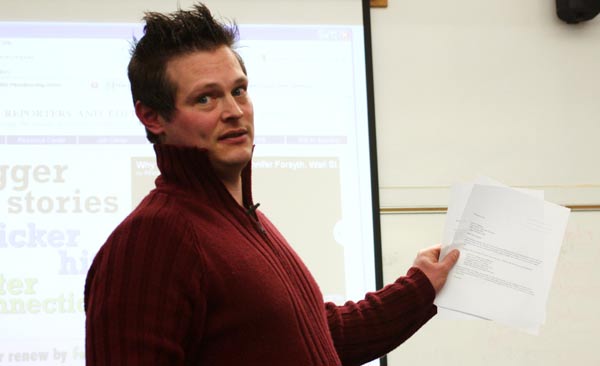Dig into public records to unearth important stories, Tribune reporter advises
February 13th, 2011 Posted in OpinionBy Satenik Sargsyan
Photos by Armen Hovsepyan
LOGAN—If All the President’s Men inspires you to become a modern-day Carl Bernstein or Bob Woodward, it is time to learn about the nuances of investigative reporting.
Salt Lake Tribune crime reporter Nate Carlisle visited the USU campus this week to do exactly that: share his professional experience with journalism students and talk about the in’s and out’s of investigative journalism.
 Carlisle discussed with a group of 50+ journalism students and faculty ways to become effective reporters, including joining the national association of Investigative Reporters and Editors (IRE), an international journalists’ organization based at the University of Missouri that offers resources for reporters. Carlisle also provided examples of his work to give students an idea of how real-life investigations work.
Carlisle discussed with a group of 50+ journalism students and faculty ways to become effective reporters, including joining the national association of Investigative Reporters and Editors (IRE), an international journalists’ organization based at the University of Missouri that offers resources for reporters. Carlisle also provided examples of his work to give students an idea of how real-life investigations work.
“A lot of people think that it’s a lot of work for many hours a day that they are not going to have time for, but it’s not true,” Carlisle said. “You can do a lot of this stuff in your daily routine: just a little bit here and there when you are working on other stories, and you’ve got a story.”
Like a gruff newsroom editor, Carlisle started his presentation by assigning stories to the USU students based on GRAMA (Government Records Access and Management Act) requests to police and USU officials to dig into a variety of possible stories through public records: NCAA reports on Aggie sports over the past two years, Utah Board of Regents expenditures, records on USU fraternities and sororities, general USU audits.
Public records often provide the grist for important and interesting stories, Carlisle said.
There is nothing more important to the effective journalist than asking questions, he said. Stay curious, not only about breaking news but also day-to-day events.
Curiosity has resulted in some of Carlisle’s best stories. In a recent example, he spent weeks, a little at a time, following up on a report from the Salt Lake police about the “top” parking violators in the city. Eventually, Carlisle reported that the city was trying to collect more than $5 million in outstanding parking tickets. And the biggest scofflaws are a couple, Natae Neal and Charles R. Garcia, who owe the city $5,671.43.
“After a few requests about parking violations, I found that they were the top names on the list,” Carlisle said. “The hardest part was finding them.”
Journalistic investigations are often team efforts, he said, citing the example of the summer 2009 collapse of Logan’s Northern Canal, in which residents were killed and homes destroyed when a water canal failed and flooded Logan’s Island neighborhood.
Working with a fellow Tribune reporter, Carlisle learned that the dangers posed by the canal should have been no surprise.
“In about 24 hours, we had this fast investigation of the history of Logan Canal,” Carlisle said.
“One of the things about college towns is that anything that happens in a college town eventually ends up in somebody’s master’s or doctoral thesis. So I went on USU’s library webpage and started searching.”
Carlisle and fellow Tribune reporter Matthew LaPlante found student dissertations in USU’s library that warned about safety issues on Logan’s Canal. Working with other journalists, they then turned to local farmers to ask about their concerns about the canal, and found sources who had worried about the canal’s safety for years.
In today’s newsroom, it is “rare, rare, rare” to work only on investigations, he said, but the techniques should be part of every journalist’s professional toolbox. And not every investigation can bring down a president.
“Sometimes investigative reporting is just about two dummies rounding up $6,000 in parking fines. It’s fun.”
Carlisle says joining IRE—Investigative Reporters and Editors—provides a dramatic advantage to journalism students against their competitors. And, he said, “It’s dirt cheap for students—just $25 a year.”
“You guys can’t beat this. List your membership on resumes when you’re applying for jobs, and it automatically puts you ahead of 99.9 percent of others who are competing with you for the same job or internship.”
The point, Carlisle told the student journalists, is that information exists in public records that may become important stories.
“I gave you these examples to make you not feel so intimidated by the concept of investigative reporting,” he said.
“Even when you’re working on other stories, it’s important to set time aside to work on a specific project. You’d be amazed by how much you can get done in 15 or 20 minutes a day within two weeks or a month.”
Carlisle’s workshop was sponsored by the Department of Journalism & Communication’s Morris Media & Society Events Series.
TP
Tags: IRE, journalism, Nate Carlisle, Salt Lake Tribune

Sorry, comments for this entry are closed at this time.